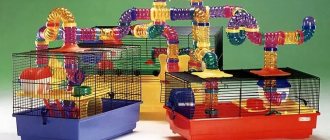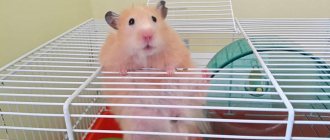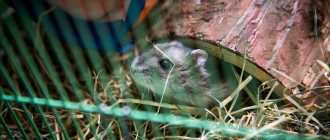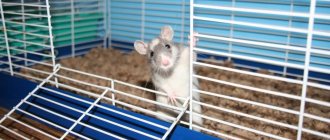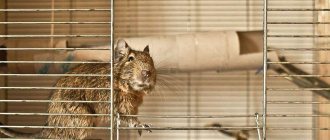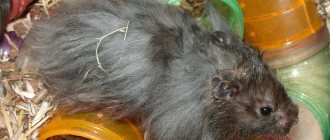What is required for maintenance
Proper keeping of a hamster at home can not only improve the well-being and health of the small rodent, but also prolong its life. If you create all the conditions for a comfortable existence, the hamster will live a long and happy life without stress.
To keep a pet hamster you need:
- cell;
- house;
- toys;
- feeders 2 pieces;
- drinking bowl;
- running wheel, ball, maze, playground or tunnel.
When choosing a cage, you need to take into account the number and type of hamsters you plan to keep. It is not recommended to house several hamsters in one cage, but in practice it turns out differently. The minimum cage size for one rodent is 60 by 40 cm. It is important that the bars of the cage are positioned horizontally, since hamsters are very active and love to climb the walls of the cage.
The cage must be selected specifically for small rodents. Since the distance between the rods plays an important role. If you are planning to get dwarf hamsters, choose a distance so that a small hamster cannot fit between them.
To keep hamsters, they often buy a cage. But you can use an aquarium. It is important that the size of the aquarium also corresponds to the minimum size of 60 by 40 cm per pet, and the number of hamsters living.
Under no circumstances should hamsters be kept in cardboard boxes or plastic containers. Hamsters are rodents; their teeth grow throughout their lives. They will instantly chew up a dwelling made of fragile material and run away. Finding and catching an escaped hamster is not an easy task. But besides this, he can also get poisoned.
Rules for arranging a home for a hamster
In nature, these animals live in burrows. So the domestic animal also needs an impromptu mink. He hides there and sleeps. Sometimes he can store food supplies in the house.
For large breeds of hamsters, carefully choose a cage so that the holes in it correspond to the size of the animal , otherwise it risks getting stuck in them.
Simple tips for creating a cozy place for your hamster inside the cage:
- Napkins or torn paper can serve as a house, from which the pet will make a nest for itself.
- Pieces of non-woolen fabric are placed in the house.
- You can buy ready-made nesting material for rodents.
- Periodically it is necessary to clean the hamster's house, and at the same time clear it of old food supplies.
Your pet feels more comfortable having a secluded place to retreat to..
In what cases can hamsters be given apples?
Pros and cons of content
Pros of keeping a hamster
- low cost of a hamster;
- low cost of accessories for maintenance;
- takes up little space;
- does not require special care and knowledge;
- does not make noise;
- no wool;
- no need for daily walks;
- you can keep one hamster, without a pair;
- does not pose a danger to both adults and children;
- easy to breed;
- easy to place the babies.
Disadvantages of keeping a hamster
- they sleep during the day and are active at night;
- unpleasant odor if you do not clean up food debris and excrement daily;
- low life expectancy, from 2 to 3 years;
- some individuals hibernate, depending on the species and conditions of detention.
Important nuances of hamster pregnancy
Sometimes owners find out that the pet was pregnant only during childbirth. But some animal lovers specifically purchase a pair of rodents of different sexes for breeding purposes.
Unexpected birth
If a hamster gives birth, all other rodents must be removed from the cage immediately.
Over the next 2 weeks, interference in the life of the cubs, penetration into the cage should be minimal.
Refuse cleaning and do not touch newborns. The appearance of foreign odors will frighten the female and may lead her to decide to eat the hamsters.
Planned replenishment
Take care of proper nutrition for the pregnant woman. Her diet includes more protein foods, fruits, vegetables, and also increases the amount of food and liquid due to increased energy costs. It is necessary to regularly change the water in the drinking bowl. It is better to use spring or bottled water, since tap liquid contains a lot of bleach that is harmful to rodents.
The partner and other relatives should be moved to another cage. Neighbors can disturb a pregnant woman and create stress, so before giving birth and during the first weeks after the birth of the cubs, it is better for the female to remain alone.
Choosing a location for the cage
Often owners do not pay attention to where to place the hamster's cage. This is a rather important point, which affects both the health and life expectancy of the animal.
Things to consider when choosing a location for a cage:
- Avoid direct sunlight on the cage;
- avoid bright light;
- limit access to the cage for other animals;
- avoid drafts;
- there should be no temperature changes in the room;
- do not place under air conditioning;
- do not place near heating devices;
- there should be no strong odors or smoke in the room;
- do not place near a TV, radio, or stereo system;
- do not place the cage in a walk-through area;
- Do not place it in a children's playroom, as hamsters are afraid of sharp and loud sounds.
For the cage you need to choose a quiet, non-passable place. The cage should not be moved frequently. The optimal temperature for keeping hamsters is 20-25 degrees.
It is necessary to install a house in the cage so that the hamster can rest during the daytime and feel safe. Also in the cage you need to put 2 feeders and a drinking bowl. Feeders with drinking bowls must be attached to the bars of the cage, otherwise an active animal will definitely turn over and trample the contents. One feeder is needed for the grain mixture, which is the main feed, the other is needed for succulent feed.
It is worth considering that hamsters are very mobile and active animals. They definitely need to buy and install a treadmill, ball, tunnels, and labyrinths in the cage. Special playgrounds for hamsters are sold, which already include the listed attractions, as well as various toys for the hamster.
Reasons why a female may eat her children
Eating one's own offspring is possible for several reasons. Most often, females destroy their cubs due to:
- Stress. The hamster may become nervous if other animals or people enter the cage in the first weeks after giving birth.
- Presence of pathologies in the baby. In nature, mothers often eat sick or weak newborns whose chances of survival are low. This solution allows the female to replenish the supply of protein necessary for milk production. In addition, bacteria that are dangerous to other newborns will not begin to multiply on the body of the deceased cub.
- Too many babies. The female is not able to feed everyone, so she eats several to increase the others’ chances of survival.
Hamster care
Cleaning
One of the main disadvantages of keeping hamsters is the unpleasant smell from the cage. To avoid this, you need to clean the cage daily and keep it clean. However, frequent cleaning worries the hamster and leads to stress, which greatly reduces life expectancy.
Before you start cleaning the cage, you need to move the hamster to another place. Then remove any remaining food, wash the feeders and drinking bowls, check and remove supplies from the hamster’s pantry, and remove excrement. As soon as you have finished cleaning, you need to return the hamster back.
To prevent an unpleasant odor from excrement, the bottom of the cage is covered with corn or cellulose filler. Newspapers or sawdust are often used as bedding. However, such material is one of the reasons for the unpleasant odor and the cage needs to be cleaned much more often.
General cleaning is carried out 2-3 times a month. This type of cleaning includes a complete change of filler and a complete wash of the cage.
Feeding
Hamsters are omnivores, so it is important to know what you can and cannot feed your hamster.
- The basis of a hamster's diet is a grain mixture. You can purchase ready-made grain food at a pet store, or purchase grains separately and mix them yourself.
- Vegetables and fruits must be included in a hamster's diet. Vegetables are a source of fiber, which aids digestion, and fruits are an excellent source of vitamins. Among the vegetables, the hamster is often fed carrots, cucumbers, bell peppers and zucchini. Hamsters are very fond of apples and pears as fruits.
- It is also worth taking care of your pet's health. Hamsters need to wear down their teeth, which grow throughout their lives. To do this, you can hang a mineral stone in the tap hole, which is also beneficial for the body. Hamsters are also given branches of apple, pear, and birch trees.
We discussed a complete list of foods that can be given to a hamster in the article What does a hamster eat.
Communication
- Hamsters are very active and sociable pets. They quickly get used to humans and are easy to tame. It is important to avoid long breaks when in contact with a hamster. Because the rodent also quickly loses the habit and has to be tamed again.
- Contact with the hamster should be established gradually. It is not recommended to disturb the hamster during the first days in the house. During the first week, he needs to be given time to settle into the new territory and get used to the person, his smell and voice.
- It is worth considering that the hamster is a nocturnal animal. Under no circumstances should he be woken up during the day. Also, when communicating, you should not make loud sounds, make noise, shout or make sudden movements.
- You should handle your hamster with extreme caution. Taking him from the back is highly discouraged, as this causes him to associate it with an attack by a predator. You need to place your palm and wait for the hamster to climb onto it.
- It's worth being careful. Do not squeeze it too tightly in your hands, and also make sure that it does not slip out of your hands. Hamsters can be injured if they fall from a height.
- Hamsters are very clean. There is no need to wash them unless they are soiled with feces. If you still need to bathe your hamster, you need to make sure that water does not get into the eyes, ears and nose. After bathing procedures, you cannot blow dry your hamster!
Hamsters at home live on average 2-3 years. They are very timid and often exposed to stress. If you follow simple rules for caring for and keeping hamsters at home, they will delight you throughout their lives.
How to decorate a rodent's home for the holidays?
To feel the New Year's mood, the places where pets live are also decorated. Cages with pallets on the outside around the perimeter can be decorated with tinsel. To do this, in some places it needs to be fixed with tape. Then they hang the toys outside the pet’s home. On the outside of the drinking bowl there are areas inaccessible to the hamster, which are decorated with snowflakes or balls .
Decorating your hamster's cage before Valentine's Day is also fun. Its outer part is covered with red or crimson hearts. It’s great if an aquarium is reserved for the animal’s home. Decorating it from the outside is much safer than decorating a cage, because in this case the pet will not be able to reach them.
After you have become familiar with the nuances of arranging a hamster's home, buy the animal you like. Give him everything he needs and it will ensure his health for many years .
Price of fillers
What is the best filler for a hamster cage? The comparison table shows the average prices for different types of filler and indicates the approximate service life of the filler per fill.
| Filler | Cost, 10 liters | Backfill service life |
| Sawdust | 150 rubles | 3-5 days |
| Granular filler | 450 rubles | 5-7 days |
| Straw | 250 rubles | 2-3 days |
| Corn filler | 500 rubles | 7-9 days |
| Hay | 400 rubles | 2-3 days |
| Napkins, toilet paper | 10 rub. per pack | 1-2 days |
